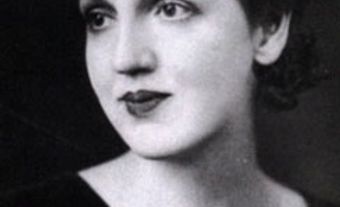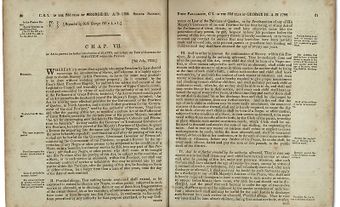Early Life and Enslavement
Angélique was born in Madeira, Portugal, around 1705. Little is known of the first 20 years of her life. She may have been first enslaved in Portugal, an active port of the Atlantic slave trade. It was likely there that Angélique was sold to the Flemish merchant Nichus Block when she was in her early teens. Angélique was taken by boat to North America, possibly stopping in Flanders (what is now northern Belgium), which had close trading ties with Portugal. Angélique arrived in New England, where she was purchased at age 20 by the French merchant François Poulin de Francheville in 1725. Francheville brought Angélique back to his hometown of Montréal to work as a domestic slave. (Between the time Angélique left Europe and arrived in Montréal, she had been sold at least twice.)

When Francheville died in 1733, ownership of Angélique passed to his widow, Therese de Couagne, who is thought to have renamed the enslaved woman from Marie-Joseph to “Angélique,” after her deceased daughter. While enslaved for nine years at the Francheville home, Angélique had three children, none of whom lived beyond infancy. Birth records indicate that the father was Jacques César, a Madagascar-born slave owned by a Francheville family friend. Some researchers believe that the couple was forced by their owners to produce offspring. Angélique also had a lover, an indentured White labourer from France named Claude Thibault, with whom she tried to flee from enslavement and who was believed to have helped her set fire to Montréal.
Fight for Freedom
In December 1733, Angélique asked her mistress for her freedom, a request that Madame de Francheville denied. This infuriated Angélique, who “went on a small reign of terror in the household.”
She talked back to her owner, threatened her with death by “roasting,” quarreled with the other servants in the house, threatened them, too, with “burning,” and made life so unbearable for her fellow servant Marie-Louise Poirier that she quit her job. ( The Hanging of Angélique, 2006)
In early 1734, Francheville sold Angélique to François-Étienne Cugnet of Québec City for 600 pounds of gunpowder. She was waiting for the ice to thaw on the St. Lawrence River in order to send Angélique by boat. It was rumoured that Cugnet would in turn sell Angélique into enslavement in the West Indies. Upon hearing news of her sale, Angélique threatened to burn down Francheville’s house with her in it.
Soon after, Angélique ran away with Thibault. Her intent was to return to Portugal, the land of her birth. The couple set fire to Angélique’s bed at Alexis Monière’s home — where Francheville had chosen to move them temporarily — and fled in the direction of New England, where they hoped to catch a ship bound for Europe. Two weeks later, Angélique and Thibault were tracked down by the police in nearby Chambly. Angélique was returned to her owner to await transportation to Québec City, and Thibault was sent to jail. Once she returned to Montréal, Angélique continued to state that she would burn down her mistress’ house because she wanted to be free.
Arson Accusation
On the evening of Saturday 10 April 1734, a large portion of Montréal — the merchants’ quarter — was destroyed by fire. At least 46 buildings, mainly homes, were burnt, plus the convent and hospital of the Hôtel-Dieu de Montréal. Angélique was accused of starting the fire and arrested by police on 11 April. She was taken to court the following morning, where she was charged with arson, a capital crime punishable by death, torture or banishment. In the French legal system of the 18th century, the accused was presumed guilty, and in New France, there were no trials by jury, only inquisitorial tribunals in which the defendant was meant to prove her innocence. Lawyers were banned from practicing in the colony by Louis XIV.
On 12 April 1734, Angélique, at 29 years old, was brought before Pierre Raimbault, judge for the jurisdiction of Montréal. With Raimbault was François Foucher, the king’s procurator (chief attorney and prosecutor), and four notaries. Also present was the king’s scribe, an important personage in matters of the court, Claude-Cyprien-Jacques Porlier.
So began one of the most spectacular trials to come out of 18th-century Canada. Over 24 witnesses were called, 23 of whom— including a five year old girl — stated that they believed Angélique had set the fire because at one point or another, she had told them that she would. One witness said that she saw Angélique carrying a pot of live coals up to the roof minutes before the fire started. The court felt that she had intended to flee enslavement, and had set the fire in order to cover her tracks.
After a six week tribunal, Angélique was found guilty and sentenced to death. She was to have her hands cut off and be burned alive. The sentence was appealed to the superior court in Québec City, where the death penalty was upheld and the gruesome aspects of the sentencing lessened. Angélique would be tortured, hanged, and then her body burned. She returned to Montréal to await her death. Throughout her trial, at both the lower court in Montréal and the upper court in Québec, she denied setting the fire.
Execution
On the morning of 21 June 1734, Angélique was tortured in her jail cell by means of the brodequins, a medieval torture instrument that crushed her leg. The use of torture was standard in 18th-century prosecution, and in Angélique’s case, the court wanted her to admit to setting the fire. Under torture, she broke down and confessed. Nevertheless, she refused to name Claude Thibault as co-conspirator and co-arsonist. (The judges believed that Thibault and Angélique had set the fire together.)
After the torture, Angélique, dressed in a white chemise and holding a burning torch in her hand (the symbol of her crime), was placed in a garbage cart and taken to the portal of the Notre-Dame Basilica, where she confessed to her crime, and begged pardon of god, the king and the people. She was then hanged. The hangman and torturer was Mathieu Léveillé, an enslaved Black man employed as royal executioner. Angélique’s body was displayed on a gibbet for two hours. At 7:00 p.m., her body was placed on a pyre and burnt, her ashes gathered and cast to the four winds.
Legacy
The burning of Montréal, as well as the arrest and subsequent trial of Angélique, reveals much about the nature of enslavement in Canada, a legal institution that existed for over two hundred years. It is possible that Angélique did not set the fire. But she made an ideal scapegoat for the crime: she was Black, enslaved, poor, and a foreigner, and so in every aspect was a social outcast. As a slave, Angélique had no rights that New France or White society would respect.
On the other hand, Angélique may have set the fire. She had many grievances against White society in Montréal. Whites had enslaved her, stripped her of her freedom and human rights, and taken her from a homeland that she clearly loved. In Montréal, she had attempted at least once to escape from enslavement, but was thwarted. Arson had played a role in that earlier escape. Centuries later, Marie-Joseph Angélique has become a symbol of Black resistance and freedom.
Based on transcripts of her tribunal, playwright Lorena Gale wrote Angélique, which was staged in 1995 and published in 2000. In February 2012, the public square across from Montréal’s city hall was named Place Marie-Josèphe Angélique in her honour.
(See also The Hanging of Angelique.)

 Share on Facebook
Share on Facebook Share on X
Share on X Share by Email
Share by Email Share on Google Classroom
Share on Google Classroom


